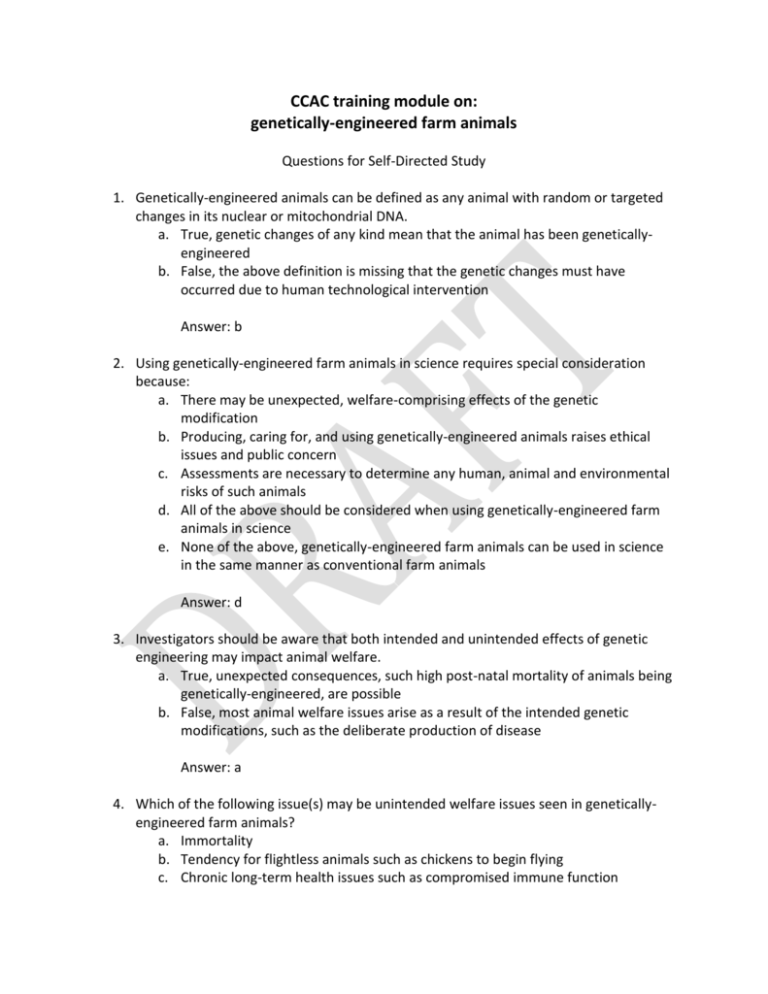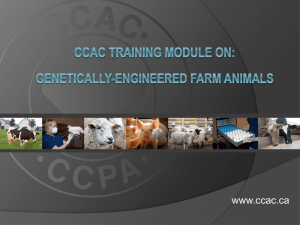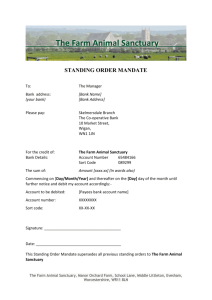Questions - Canadian Council on Animal Care
advertisement

CCAC training module on: genetically-engineered farm animals Questions for Self-Directed Study 1. Genetically-engineered animals can be defined as any animal with random or targeted changes in its nuclear or mitochondrial DNA. a. True, genetic changes of any kind mean that the animal has been geneticallyengineered b. False, the above definition is missing that the genetic changes must have occurred due to human technological intervention Answer: b 2. Using genetically-engineered farm animals in science requires special consideration because: a. There may be unexpected, welfare-comprising effects of the genetic modification b. Producing, caring for, and using genetically-engineered animals raises ethical issues and public concern c. Assessments are necessary to determine any human, animal and environmental risks of such animals d. All of the above should be considered when using genetically-engineered farm animals in science e. None of the above, genetically-engineered farm animals can be used in science in the same manner as conventional farm animals Answer: d 3. Investigators should be aware that both intended and unintended effects of genetic engineering may impact animal welfare. a. True, unexpected consequences, such high post-natal mortality of animals being genetically-engineered, are possible b. False, most animal welfare issues arise as a result of the intended genetic modifications, such as the deliberate production of disease Answer: a 4. Which of the following issue(s) may be unintended welfare issues seen in geneticallyengineered farm animals? a. Immortality b. Tendency for flightless animals such as chickens to begin flying c. Chronic long-term health issues such as compromised immune function d. All of the above are examples of issues potentially affecting the welfare of genetically-engineered farm animals e. None of the above, most potential welfare consequences of genetic engineering methods have been identified and corrected Answer: c 5. Investigators familiar with the ethical concerns regarding producing and working with genetic-engineered farm animals will be better prepared for mitigating potential welfare issues caused by the specific methodologies used. a. True, understanding and justifying the necessity of specific genetic engineering methods, as well as an awareness of their previously demonstrated effects, may help investigators avoid or minimize future welfare impacts b. False, unintended negative welfare effects are an unavoidable aspect on such scientific work and only need to be addressed if an animal care committee (ACC) requires Answer: a 6. Which of the following is false regarding the regulations governing geneticallyengineered (i.e., biotechnology-derived) animal use and production in Canada? a. All animals manipulated through science and engineering are considered to be biotechnology-derived animals b. The Canadian Food Inspection Agency (CFIA) is solely responsible for regulating the environmental release and indirect human health impacts of geneticallyengineered animals c. Under the New Substance Notification Regulations (Organisms) (NSNR(O)), all new biotechnology-derived animals must undergo a risk assessment d. Environment Canada and Health Canada must be notified prior to the import of a new biotechnology-derived animal e. All of the above are true in regards to the regulations governing geneticallyengineered animal use and production Answer: b 7. The Animal Feed Division of the Canadian Food Inspection Agency (CFIA) considers products from somatic cell nuclear transfer (SCNT) animal clones to be “novel feeds” and therefore requires that an assessment be conducted before these products are allowed into the food chain. a. True, a full assessment is required to ensure the products will have no detrimental human, animal or environment impact b. False, a full assessment is only required if the products are being used as animal feeds Answer: a 8. Which of the following is most true in regards to the identification and tracking of genetically-engineered farm animals? a. Genetically-engineered farm animals require two redundant forms of identification b. The Canadian Sheep Identification Agency (CSIA) allows for genetic modification information to be assigned to its tagging system c. Ear tags make good permanent forms of ID d. It is not possible to permanently identify genetically-engineered chickens e. All of the above apply to identification and tracking of genetically-engineered farm animals Answer: a 9. When transporting genetically-engineered farm animals the following is most true: a. If animals are accidentally released, the Canadian Environmental Agency will deploy a “search and destroy” method of animal recovery b. If animals are accidentally released, the Canadian Environmental Agency will provide a team for the identification and recovery of animals c. Transport companies should have experience and contingency plans for the recovery of accidentally released animals d. Drivers should not attempt to capture accidentally released animals in order to protect their own personal health and safety e. When transporting small groups, genetically-engineered animals should be mixed with larger groups of conventional raised animals to prevent falling during transport Answer: c 10. Genetic engineering can have impacts on animal physiology which will require that special considerations be given to the animals during transportation: a. True, if animals are immune compromised for example, extreme care should be put into ensuring the vehicle is sanitized properly b. False, no known effects of genetic engineering impact animals’ ability to withstand standard transportation standards Answer: a 11. In order to maintain secure confinement of genetically-engineered farm animals, the follow is required: a. Maintaining at least two physical barriers at all times b. Maintaining individual housing units of each animal c. Monitoring animals 24 h/d using a digital video surveillance system d. All of the above are required to maintain secure confinement of geneticallyengineered farm animals e. None of the above, investigators can achieve secure confinement by adhering to agricultural industry standards Answer: a 12. Some genetic modifications may substantially alter physiological functioning of the animals to the extent that: a. Animals confined in situations without exposure to natural sunlight may be able to produce their own vitamin D b. Milk producing animals are able to do so without producing offspring c. Dramatic increases in disease resistance negate the need for biosecurity measures d. Animals may be less able to absorb nutrients from their diet, potentially creating nutritional deficiencies e. All of the above are potential effects of genetic modifications on physiological functioning Answer: d 13. The end use of the animals and their products is very important in determining the feeding regimes of genetically-engineered farm animals because: a. It may be necessary to provide genetically-engineered farm animals feeds which do not contain animal by-products b. Time of feed delivery alters animals ability to produce usable pharmaceutical products c. Genetically-engineered farm animals are extremely picky eaters and easily lose weight when not fed their favourite foods, making the collection of pharmaceutical products difficult d. The offspring of genetically-engineered farm animals are easier to feed if kept with the dams for at least one week, making it necessary to account for pharmaceutical product loss e. None of the above Answer: a 14. When determining the optimal care of genetically-engineered farm animals, it is useful to: a. Characterize the consequences of any genetic modifications and provide these to pharmaceutical companies so they may develop drugs to counter the negative impacts b. Develop mitigation strategies for the consequences of the genetic modifications employed and use these as guides for the care of future generations c. Identify an animal with the least amount of negative health effects caused by the genetic modification employed and clone this animal for future use d. Care for the animals under conventional-care standard operating procedures (SOPs); animals can be acclimated to most care regimes e. All of the above should be employed when determining optimal care of genetically-engineered farm animals Answer: b






